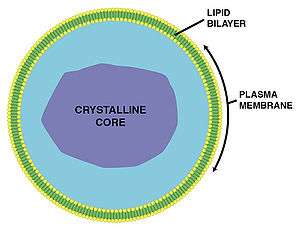Acatalasia
Acatalasia is an autosomal recessive peroxisomal disorder caused by absent or very low levels of the enzyme catalase.[2] Catalase breaks down hydrogen peroxide in cells into water and oxygen. Low levels of catalase can cause hydrogen peroxide to build up, causing damage to cells.
| Acatalasia | |
|---|---|
| Other names | Acatalasemia, or Takahara's disease[1]:809 |
 | |
| Basic structure of a peroxisome | |
| Specialty | Endocrinology |
Presentation
The disorder is relatively benign, although it causes an increased incidence of oral ulcers, and can under rare circumstances lead to gangrene.[3][2] Symptoms primary affect children.[4]
Genetic
Acatalasia is often the result of mutations in both copies of the CAT gene which codes for the enzyme catalase.[5] There are multiple types of mutation that can cause this condition. Inheriting a single CAT mutation results in hypocatalasia, in which catalase levels are reduced, but still at functional levels.[6]
Diagnosis
This disorder is commonly diagnosed pouring hydrogen peroxide on the patient's blood sample. Instead of a very bubbling reaction, blood turns brown-colored, which means the patient suffers from acatalasia
Management
Epidemiology
In parts of Japan, this condition has been found in approximately 1.4% of people.[4] Researchers estimate that the condition occurs in 1 in 20,000 people in Hungary and Switzerland.[5]
History
In 1948, Dr. Shigeo Takahara (1908–1994), a Japanese otolaryngologist first reported this new disease.[7] He had examined a patient with an oral ulcer. He had spread hydrogen peroxide on the diseased part, but oxygen was not generated due to the lack of catalase.
See also
References
- James, William D.; Berger, Timothy G.; et al. (2006). Andrews' Diseases of the Skin: Clinical Dermatology. Saunders Elsevier. ISBN 978-0-7216-2921-6.
- Reference, Genetics Home. "acatalasemia". Genetics Home Reference. Retrieved 7 November 2017.
- Takahara, Shigeo; Hamilton, H. B.; Neel, J. V.; Kobara, T. Y.; Ogura, Y.; Nishimura, E. T. (1960). "Hypocatalasemia: a new genetic carrier state". Journal of Clinical Investigation. 39 (4): 610–619. doi:10.1172/JCI104075. PMC 293346. PMID 13836629.
- Bissonnette, Bruno; Luginbuehl, Igor; Marciniak, Bruno; Dalens, Bernard J. (2006). Acatalasia/Acatalasemia. Syndromes: Rapid Recognition and Perioperative Implications. The McGraw-Hill Companies.
- "Acatalasemia". Genetics Home Reference. Retrieved 2015-09-28.
- "OMIM Entry - # 614097 - ACATALASEMIA". www.omim.org.
- Takahara, S.; Miyamoto, H. Three cases of progressive oral gangrene due to lack of catalase in the blood. Nippon Jibi-Inkoka Gakkai Kaiho 51: 163 only, 1948.
External links
| Classification |
|---|